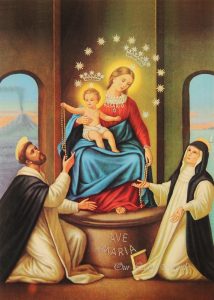Our Lady of the Rosary

On October 7, the first Sunday of October in the year 1571, Don Juan of Austria gained his famous naval victory over the Turks at Lepanto. In thanksgiving for this event, which he attributed to the intercession of the Blessed Virgin through the recitation of the Holy Rosary, St. Pius V instituted an annual feast under the title of Our Lady of Victory. His immediate successor, Gregory XIII, changed the title to that of the Rosary, and granted its Office to all churches in which there was an altar dedicated to Our Lady of the Rosary.
In 1716, the army of the Emperor Charles VI, under Prince Eugene, gained a remarkable victory over the Turks near Belgrade, on the Feast of Our Lady of the Snows, at a time when the members of the Society of the Holy Rosary were offering solemn prayers in Rome. Soon after, the Turks were forced to raise the siege of Corcyra. Clement XI, in memory of this, extended the feast of the Most Holy Rosary to the Universal Church. Benedict XIV caused an account of all this to be inserted into the Roman Breviary, and Leo XIII raised the feast to the rank of a feast of the second class. He also added the Litany of Loreto the invocation: Queen of the Most Holy Rosary, pray for us.
In 1961, the title of this feast became: Our Lady of the Rosary.
According to a venerable tradition, the devotion of the Holy Rosary was revealed to St. Dominic by the Blessed Virgin.

